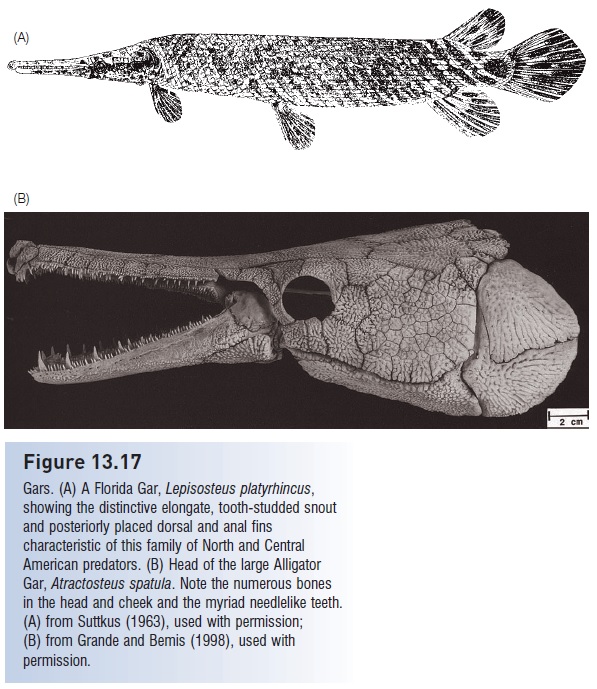Chapter: The Diversity of Fishes: Biology, Evolution, and Ecology: Living representatives of primitive fishes
Subclass Neopterygii, Order Lepisosteiformes (or Semionotiformes): the gars

Subclass Neopterygii, Order Lepisosteiformes (or Semionotiformes): the gars
The gars and Bowfin are descendants of the palaeoniscoids that dominated fresh and marine waters for 200 million years from the Mid Devonian into the Mesozoic Era.
Traditionally, gars and Bowfin were considered members of the order Holostei, which also included a variety of extinct fishes. However, most recent analyses conclude that holosteans are paraphyletic, more a grade of development than a true clade. The two modern groups differ in many important respects and their relationships to the palaeoniscoids, and position in the lineage leading to modern teleosts, are a matter of discussion. Both groups are considered neopterygian because of shared jaw, tail, and dermal armor characteristics. Most workers consider gars to be more primitive and place them in their own division (Ginglymodii), but some viewAmia as the more primitive group (Normark et al. 1991; Olsen & McCune 1991; Grande &Bemis 1998).
All seven species of living gars are in the family Lepisosteidae, four in Lepisosteus and three in Atractosteus (Fig. 13.17). These elongate, predatory fishes are restricted to North and Central America and Cuba; five species occur east of the Rocky Mountains in North America, the remaining species occur in Central America. Gars typically inhabit backwater areas of lakes and rivers, such as oxbows and bayous. Oxygen tension in such habitats is often low and gars must breath atmospheric air at these times, using their compartmentalized, highly vascularized gas bladder as a lung (Smatresk & Cameron 1982; Smith & Kramer 1986).

Figure 13.17
Gars. (A) A Florida Gar, Lepisosteus platyrhincus, showing the distinctive elongate, tooth-studded snout and posteriorly placed dorsal and anal fins characteristic of this family of North and Central American predators. (B) Head of the large Alligator Gar, Atractosteus spatula. Note the numerous bones in the head and cheek and the myriad needlelike teeth. (A) from Suttkus (1963), used with permission; (B) from Grande and Bemis (1998), used with permission.
Gars have entirely ossified skeletons. Their primitiveness is evident in their hinged, diamond-shaped, interlocking ganoidlike scales and abbreviate heterocercal caudal fin. Ganoin is an enamel-like material on the upper surface of the scale and characterized the squamation of the Paleozoic and Early Mesozoic palaeoniscoids, which are thought to be ancestral to (or a sister group of) modern teleostean groups. The gars have retained this primitive trait. The same logic applies to the caudal skeleton. Abbreviate
A constricted and ossified notochord may be a derived innovation in lepisosteids rather than an indication of ancestral status to teleosts, since lepisosteid vertebral centra are essentially unique among living fishes. Gar centra are opisthocoelous, being concave on their posterior surface and convex on the anterior surface, allowing for a “balland- socket” articulation (most fishes have amphicoelous vertebrae in which both surfaces are concave; only one blenny species, some tailed amphibians, and a few birds have opisthocoelous vertebrae) (Suttkus 1963; Wiley 1976). The name Ginglymodii refers to the hinged articulation between the vertebrae.
The Alligator Gar, Atractosteus spatula, is the largest member of the family and one of the largest freshwater fishes in North America (Fig. 13.18). It attains a length of 3 m and a weight of 140 kg (Suttkus 1963). Although most gars are considered water column predators on other fishes and often hover just below the surface, Alligator Gars also feed extensively on bottom-dwelling fishes and invertebrates, and scavenge on benthic food (Seidensticker 1987). Alligator Gars, as well as other species, frequently enter estuarine regions (Suttkus 1963).

Figure 13.18
A large Alligator Gar caught in Texas. Photo courtesy of Jean-Francois Healias, www. anglingthailand.com.
Comparatively little is known about the life history and general biology of gars. This is unfortunate because they are ecologically important in many fish assemblages, often becoming quite abundant in rivers and backwaters. Gars are additionally interesting in that they are the only freshwater fishes in North America with toxic eggs. The eggs are distinctly green in color and can cause sickness and even death when eaten by chickens and mice. However, the possible ecological function of this toxicity, and whether it actually affects fish or invertebrates that might feed on the eggs, remains undetermined (Netsch & Witt 1962). Seven fossil species of gars are recognized, dating back to the Lower Cretaceous of North America, Europe, Africa, and India, and indicating a widespread Pangean distribution (Wiley 1976; Stiassny et al. 2004).
Related Topics